Jagdtiger
| Jagdtiger Sd. Kfz. 186 | |
|---|---|
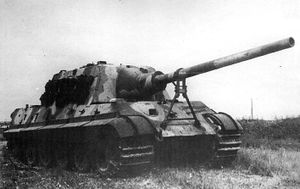 |
|
| Type | Tank destroyer |
| Place of origin | |
| Production history | |
| Number built | 88 |
| Specifications | |
| Weight | 71.7 tonnes (158,000 lb) (Henschel suspension) |
| Length | 10.65 m (34.9 ft) including gun |
| Width | 3.6 m (12 ft) |
| Height | 2.8 m (9.2 ft) |
| Crew | 6 |
|
|
|
| Armor | 250 mm (9.84 in) |
| Primary armament |
1x 12.8 cm PaK 44 L/55 |
| Secondary armament |
1x 7.92 mm Maschinengewehr 34 |
| Engine | V-12 Maybach HL 230 P30 700 PS (690 hp, 515 kW) |
| Power/weight | 9.76 PS/tonne |
| Suspension | torsion bar |
| Operational range |
120 km (75 mi) road 80 km (50 mi) offroad |
| Speed | 34 km/h (21 mph) |
The Panzerjäger Tiger Ausf. B Jagdtiger (Sd. Kfz. 186) was a German tank destroyer (self-propelled antitank gun) Jagdpanzer of World War II. It saw service from late 1944 to the end of the war on both the Western Front and Eastern Front. The Jagdtiger was the heaviest armored fighting vehicle to see service during World War II.
Although well protected and armed, it suffered from mechanical problems.
Contents |
Development
With the success of the StuG III in the tank destroyer role, the military leadership of Nazi Germany decided to use the chassis of existing armored fighting vehicles as the basis for self-propelled guns. German jagdpanzers (tank destroyers) of World War II lacked turrets, using fixed casemates instead, and as a result they were capable of mounting larger caliber guns than on turreted AFVs on the same chassis. The lack of turrets also reduced their production time and cost, as fewer complex components need to be manufactured.
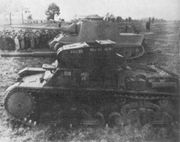
In early 1942 a request was made by the Army General Staff to mount a 128 mm gun on a self-propelled armored chassis. On May 18, 1942 Adolf Hitler ordered that the 128 mm gun be utilized in the tank destroyer role, rather than for infantry support. Firing tests of the 128 mm gun showed to have a high percentage of hits; lower caliber heavy shells such as the 88 mm and 105 mm were also tested.[1]
By early 1943 a decision was made to install a 128 mm gun on a Panther or Tiger I chassis as a heavy assault gun. The Panther chassis was considered unsuitable after a wooden mockup of the design was constructed. On October 20, 1943 another wooden mockup of the Jagdtiger was constructed on a Tiger II chassis, and presented to Hitler in East Prussia. Two prototypes were produced; a version with the eight road wheel Porsche suspension system (number 305001) and a version with the Henschel nine overlapping wheel suspension system (number 305002),[2] as used on the production Tiger II, were completed in February 1944. It was originally designated as Jagdpanzer VI, but was later named the Jagdtiger.[3] It received the series number Sd.Kfz. 186.
Design
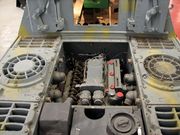
The Jagdtiger was a logical extension of the creation of Jagdpanzer designs from tank designs, such as the Jagdpanther from the Panther tank. The Jagdtiger used a boxy casemate superstructure on top of a lengthened Tiger II chassis. The resulting vehicle featured very heavy armor and the 128 mm PaK 44 L/55 gun, capable of defeating any tank fielded in World War II, even at very long ranges (+3,500 m). It had 250 mm armor on the casemate's front and 150 mm on the glacis plate. The main gun mount had a limited traverse of only 10 degrees; the entire vehicle had to be turned to aim outside that narrow field of fire.
The Jagdtiger suffered from a variety of mechanical and technical problems due to its immense weight and under-powered engine. The vehicle had frequent breakdowns; ultimately more Jagdtigers were lost to mechanical problems or lack of fuel than to enemy action.[1]
Production
150 Jagdtigers were ordered but only half that number were produced. Eleven of them, serial numbers 305001 and 305003 to 305012, were produced with the Porsche suspension (8 roadwheels); all following used the Henschel suspension (9 roadwheels).
Production figures vary depending on source and other factors such as if prototypes are included and if those made after VE day are included. Totals range from about 77 to 88 produced from July 1944 to May 1945. Approximately 48 from July 1944 to the end of December 1944; 36 from January to April 1945, serial numbers from 305001 to 305088 (such as examples from May 1945, and pre-production prototypes, and whether incomplete chassis are counted).
Some sources say no more vehicles were completed after February. Towards the end some were lacking important equipment and could not be used operationally, or could not be deployed to units.
| Date | Number produced |
Serial # |
|---|---|---|
| February 1944 | 2 | 305001–305002 |
| July 1944 | 3 | 305003–305005 |
| August 1944 | 3 | 305006–305008 |
| September 1944 | 8 | 305009–305016 |
| October 1944 | 9 | 305017–305025 |
| November 1944 | 6 | 305026–305031 |
| December 1944 | 20 | 305032–305051 |
| January 1945 | 10 | 305052–305061 |
| February 1945 | 13 | 305062–305074 |
| March 1945 | 3 | 305075–305077 |
| April 1945 | 7 | 305078–305084 |
| May 1945 | 4 | 305085–305088 |
After serial number 305011 (September 1944), no Zimmerit anti-magnetic paste was factory applied.
Combat history
Only two heavy antitank battalions (schwere Panzerjäger-Abteilung), numbered 512 and 653, were equipped with Jagdtigers, with the first vehicles reaching the units in September 1944. About 20% were lost in combat; most were destroyed by their own crews when abandoned, chiefly due to mechanical breakdowns or lack of fuel in the desperate final stages of the war.
The gun used separate-loading ammunition, which meant that two loaders were used to insert the projectile and the cased propelling charge separately. This resulted in a slow rate of fire. The tremendous amount of smoke would often give away the position of the vehicle, in addition to momentarily blinding the crew, although the latter was a moot point, owing to the very slow reload time.
Survivors
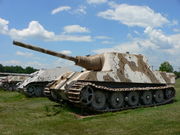
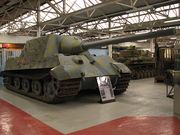
Only three Jagdtigers survived; they are on display in military museums in the United States, United Kingdom, and Russia.
The Jagdtiger on display at the United States Army Ordnance Museum in Aberdeen, Maryland, USA was produced in October, 1944 (serial number 305020). The vehicle was attached to the s.Pz.Jg.Abt 653 and had the vehicle number 331. The vehicle was captured near Neustadt an der Weinstraße, Germany in March 1945. Damage is still visible on the gun mantlet, glacis plate, and lower nose armor. This vehicle used the late version 9 tooth sprocket ring,[4] for use with the 'contact shoe' and 'connector link' style continuous track it shared with the Tiger II.
The Jagdtiger on display at the Bovington Tank Museum, England is a rare Porsche variant; the chassis number of this vehicle is 305004.[4] This vehicle was captured by British troops in April 1945 near Sennelager, Germany. The third wheel station on the left side is missing. Zimmerit was applied to approximately 2 meters high on the superstructure and the Balkenkreuz was painted in the mid section. An earlier 18 tooth sprocket ring is found on this vehicle.
The Jagdtiger on display in the Kubinka Tank Museum near Moscow is a Henschel variant; vehicle number 305083. It was acquired by Soviet forces when a Kampfgruppe of the s.Pz.Jg.Abt 653 equipped with 4 Jagdtigers surrendered in Amstetten, Austria on May 5, 1945. This Jagdtiger was acquired in mint condition with complete side skirts and later 9 tooth sprocket ring. 12 hooks on each side of the superstructure were used to carry 6 pairs of track links. This vehicle was not coated with Zimmerit. The vehicle lost all its tools but retains the MG-42 anti-aircraft mount on the rear engine deck.[4]
Variants
Aside from the 11 early vehicles with a Porsche suspension, the only variant developed was the Sd.Kfz.185.[5] The difference was that the gun used was the PaK 43 rather than the Pak 44. This was due to shortages of the latter weapon. There are some indications that about 12 were built but not completed due to lack of sights; hence they did not enter service.
Notes
References
- Carius, Otto, "Tigers in the Mud", Stackpole Books, 2003
- Duske, Heiner F. Greenland, Tony. Schulz, Frank. Nuts & Bolts Vol. 1: Jagdtiger
- Ledwoch, Janusz. Tank Series No. 207 - Jagdpanther and Jagdtiger, Wydawnictwo Militaria (1999)
- Schneider, Wolfgang. Elefant - Jagdtiger - Sturmtiger: Rarities of the Tiger Family, Schiffer Military History Vol. 18, 1990
External links
- Achtung Panzer!
- Battletanks.com
- Panzerworld
- Surviving Tiger tanks - A PDF file presenting the Tiger tanks (Tiger I, Kingtiger, Jagdtiger and Sturmtiger) still existing in the world
|
||||||||||||||||||||||||||||||||